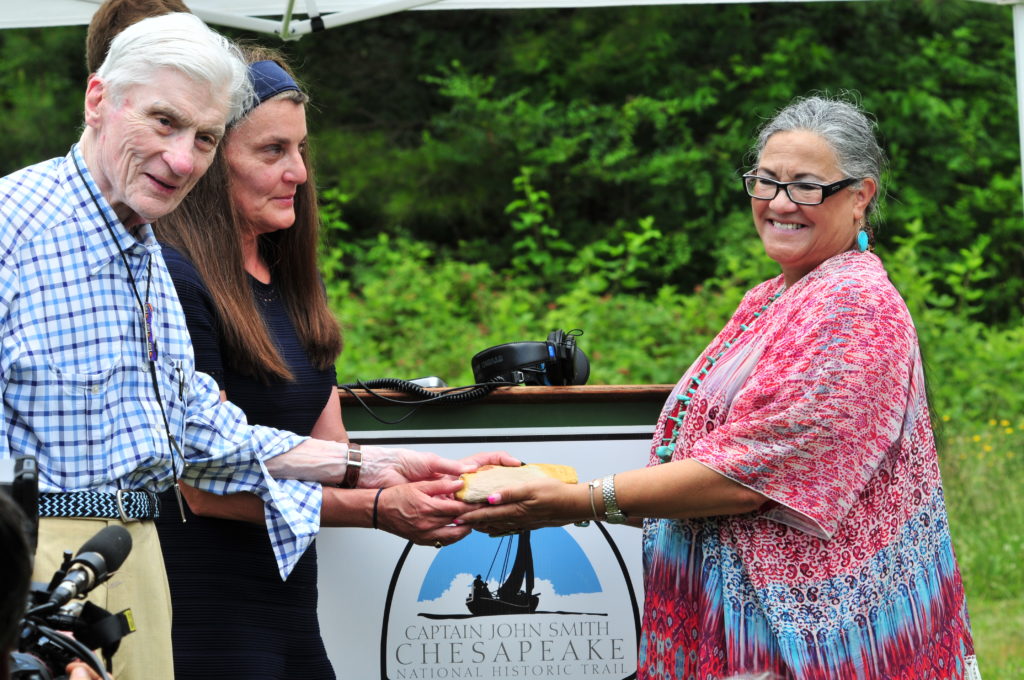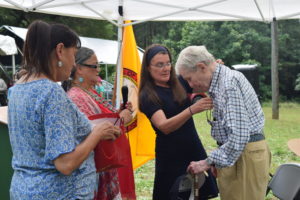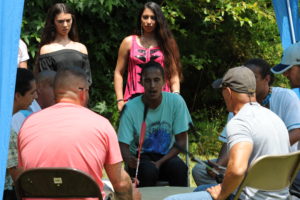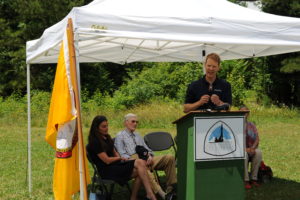Ancestral Land Donated to Rappahannock Tribe
Chesapeake Conservancy, National Park Service, U.S. Senator Join Rappahannock Tribe for “Return to the River” Event

Warsaw, VA – Today, the Chesapeake Conservancy joined members of the Rappahannock Tribe, the National Park Service Chesapeake Bay Office, U.S. Senator John Warner (VA-retired) and his daughter Ms. Virginia Warner to celebrate the donation of land to the Rappahannock Tribe.

Chief Richardson gives a gift to U.S. Senator John Warner as his daughter Virginia Warner assists.
Working with the Chesapeake Conservancy, Ms. Warner donated to the tribe nearly an acre of land on Carters Wharf Road in Warsaw, VA, which is located near a public boat landing at Fones Cliffs along the Rappahannock River. The tribe will use this land as a staging area for their Return to the River program, an effort to engage tribal youth in the traditions of their ancestors that were practiced there for thousands of years and in traditional water-related activities, such as canoeing, fishing, and camping. The Chesapeake Conservancy also donated a canoe to the tribe for this program.
 The event included a ceremonial blessing from Rappahannock Tribe Chief G. Anne Richardson, dancing and drumming by tribal members, and a formal presentation of the land transfer along with Senator Warner and Ms. Warner.
The event included a ceremonial blessing from Rappahannock Tribe Chief G. Anne Richardson, dancing and drumming by tribal members, and a formal presentation of the land transfer along with Senator Warner and Ms. Warner.
“This is a momentous day for the Rappahannock Tribe. We are very grateful to Ms. Virginia Warner and the Chesapeake Conservancy for making this possible. This land donation is deeply meaningful for our Return to the River program and will have far reaching impacts for our tribe for generations to come,” Chief Richardson said.
“I am delighted that the Chesapeake Conservancy could play a role in this culturally significant land acquisition. It’s a small tract of land with huge symbolism for the Rappahannock Tribe,” Chesapeake Conservancy President and CEO Joel Dunn said. “The tribe once again has a stake in the land where they lived for hundreds of years before Captain John Smith sailed up the river in 1608.”
 Dunn also praised the generosity of Ms. Warner. “When this opportunity presented itself, Ms. Warner stepped up to make it happen. The gift of land is an enduring one, and her legacy in supporting the Tribe’s Return to the River initiative is stamped forever.”
Dunn also praised the generosity of Ms. Warner. “When this opportunity presented itself, Ms. Warner stepped up to make it happen. The gift of land is an enduring one, and her legacy in supporting the Tribe’s Return to the River initiative is stamped forever.”
Research conducted by St. Mary’s College of Maryland shows that the Tribe was forcibly moved to various locations during the 17th century, with members finally settling in and around Essex and King and Queen Counties. The Rappahannock Tribal Center is now located at Indian Neck in King and Queen County.
“This donation coincides with a recently released report entitled, Defining the Rappahannock Indigenous Cultural Landscape. St. Mary’s College took the lead in writing the report, with significant input from members of the Rappahannock Tribe. Many others contributed to the report, including the Chesapeake Conservancy, National Park Service, and landowners on both sides of the Rappahannock River, whose interest and cooperation made on-site investigations possible,” National Park Service Chesapeake Bay Office Superintendent Chuck Hunt said.
Indigenous Cultural Landscapes are a feature of the Captain John Smith Chesapeake National Historic Trail, and are defined by the National Park Service as geographic areas that would have supported the historic lifestyles and settlement patterns of an American Indian group in their totality.
Fones Cliffs, a four-mile stretch of white colored diatomaceous cliffs rising over 100 feet above the Rappahannock River, is currently under threat of development to become a luxury resort and golf course. The cliffs provide important habitat for one of the largest concentration of bald eagles on the East Coast.
Fones Cliffs has a rich cultural history. According to the journals of Captain John Smith, Fones Cliffs was the home of three Native American towns and bore witness to an encounter between the Rappahannock tribe and the Englishmen aboard Captain Smith’s shallop. This area is a highlight to those exploring history along the Captain John Smith Chesapeake National Historic Trail and to paddlers traversing the Rappahannock.
